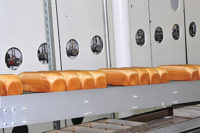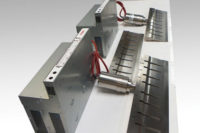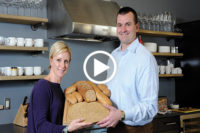NCM also expanded outside of Nebraska. It built a new flour mill in Dekatur, Ala. At the end of 1941, there was a significant drop in the available sugar supply, according to historical data compiled for AIB’s by Ron Wirtz. In addition to reduced stocks of wheat flour, there were reductions in fats, oils, and shortening, a reduction or elimination of cellophane and special wrappings and extension of the working life of baking machinery far beyond normal. During this time, “there was essentially no replacement of baking machinery for the duration of the entire conflict.”
In 1942, BEMA purchased thousands of dollars in war bonds and encouraged its members to purchase bonds and freeze equipment prices to support the war effort. Also during the decade, Americans were forced to tighten their belts. The Great Idea Finder (www.ideafinder.com) recalls that Continental Baking Co. did its part to support the war effort, as metals became so precious, the blades for bread-slicing machines were no longer available. Unsliced bread was again sold on grocery store shelves.
Despite all of the shortages and restrictions, bakers were obligated to actually increase the nutritional value of bread and bakery products and to achieve greater economies of production than ever before.
According to the AIB data, due to scarcities in other foods, consumption of wheat products in the American diet increased from 25% in 1939 to 40% in 1944. But the number of bread and cake bakers in the U.S. increased by 27% from 1943 to 1944, with a gain of 65% in production volume during that same period. White bread production increased by 11% and rye bread by 9%, with a sharp increase in cake production as well. A survey conducted in 1944 indicated that commercial bakers supplied 85% of all bread and 35% of the cake consumed in that year, although profits were lower than in 1943 because of increased ingredient costs.
Technology, standards evolve
So many variables could affect the outcome of a loaf of bread that baking was learned through lengthy apprenticeships. Even sliding bread in and out of an oven onto a peel was something that took training and practice. Thus, electric ovens were another breakthrough of the 1940s, and kept pace with the escalating demand many growing bakeries were experiencing. By the time the United States went to war, the American industrial community had been back to work and was busy mobilizing. The difficult wartime years meant conservation.
For some time, AIB had outgrown its aging facilities in Chicago. According to AIB records, more students were enrolling at the end of the war, and as early as 1945, the association considered building a new and larger facility. Late in 1945, meetings of the institute’s board of directors decided that both the AIB building and school curriculum were in need of revamping. The institute bought a lot on East Ontario Street and McClurg Court in Chicago for the sum of $119,641.71. The cost of construction, estimated at $700,000, was provided by a loan from the ABA, the parent organization of the AIB. The new quarters were more spacious, with more than 40,000 sq. ft. of space, of which the School of Baking occupied 16,000 sq. ft.

















